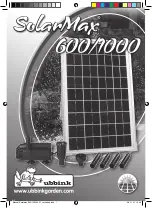
aleo
aleo solar Deutschland GmbH
| Osterstraße 15| 26122 Oldenburg | Germany | [email protected]
Page 10/60
installation instructions Edition 01/2012 en-GB-Intl (120508b)
5.
Planning
The following sections contain important information on the
planning of a photovoltaic system with aleo modules.
The information and warnings in this chapter are valid even for
the planning phase of a photovoltaic system.
Please contact the relevant authorities and, in the case of a
grid-connected PV generator, the local grid operator in order
to arrange for authorisation, as well as to clarify the installa-
tion and operational requirements. Also make sure that all
your information is up to date.
5.1.
Selecting a location
5.1.1.
Precautionary measures
DANGER
Sparks or electric arcs can be formed as a result of
short-circuits or switching operations in photo-
voltaic systems. Therefore, make sure to avoid the
installation of solar modules near easily flammable
solid, liquid, or gaseous materials.
5.1.2.
Solar irradiation
Select a location with the best possible solar irradiation for
the photovoltaic system that is going to be set up. Take into
account changes in light conditions over the course of the
entire year.
Try to select an installation location where solar modules will
receive sunlight without any shadowing from 9 am to 3 pm
local time, even on the shortest day of the year.
Avoid locations in which, over the course of the day or year,
there is systematic shadowing due to neighbouring objects or
buildings (see Ch. 5.4, Avoidance of shadowing).
5.1.3.
Planning Resources
The following sources of information can be useful for the
general
assessment of a location:
tables, e.g. about meteorological data for the
region of the location and/or
software applications, e.g. for snow load and wind
force zones etc.
These planning resources can help produce more accurate
yield predictions.
For a
defined
site, mobile measuring devices can also be
useful for assessing shadowing and measuring inclination. For
example, these are equipped with:
a GPS receiver
an electronic spirit level
an electronic compass
a fisheye camera
a display for measured values or, respectively, the
visible section of the sky including the sun's orbit
over the course of the day and year.
5.1.4.
Snow and wind loads
The necessary substructure and the installation details for
aleo modules are dependent on the highest expected load
levels (see Ch. 7, 'Mechanical Installation'). Therefore, ex-
pected snow loads and wind forces at the location should be
taken into consideration during the planning phase.
The expected pressure load level at a location is dependent
on the snow load/wind zone, the elevation, and the inclination
of the building’s roof, etc.
Always take local regulations into consideration. In Europe, for
example, these are DIN EN 1991-1-4 or DIN 1055, parts 4
and 5.
5.1.5.
Coastal areas
aleo modules are suitable for installation in coastal areas.
However, it should be avoided as much as possible that
modules come into any contact with seawater. For example,
this can be caused by:
splashing water
spray
water dripping from cliffs with salt deposits
saline particle deposits carried by the wind
Choose the distance from the coast depending on the defined
conditions at the planned installation site. As the selection of
a location is dependent on a variety of factors, aleo solar can
only provide general recommendations.
The extent to which a photovoltaic system comes into contact
with salt spray or salt water is dependent on the salinity of the
sea water, the prevailing wind and precipitation conditions,
and a number of other local circumstances such as neigh-
bouring buildings or cliffs.
5.1.6.
Proximity to facilities where animals are kept
aleo modules are suitable for installation near facilities where
animals are kept (ammonia resistance). If you have any
questions regarding test certificates, please contact aleo solar
Customer Services (see Ch. 3.2, 'Product support').
5.2.
Alignment (azimuth)
Set up the solar modules
facing south in the northern hemisphere
facing north in the southern hemisphere
These alignments generally result in the greatest yield.
G
ID A
S
04
4
c











































